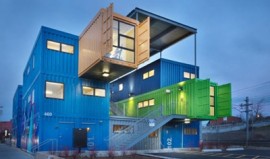Physical containers – reused in novel ways. Does that include nextgen branch offices?
Very early in my career I spent time working for a container shipping company in Sydney, Australia. At the time, Sydney Harbor was still a major commercial Australian port where its container handling facilities in White Bay enjoyed pristine views of the Sydney skyline.
The wharves and loading areas have now been relocated well away from Sydney but each time I return to Sydney I am reminded of those times when developing software still took months if not years. Productivity? I took a full year to write, test and then deploying into production just one application that “looked for empty containers”!
The first container ship purpose built for the transportation of “standard” containers – in those days, they were all 20’ by 8’ by 8’ – had made its first visit to the antipodes just three short years before. And as history now records, it was a disruptive technology on many levels. Not only did it remove the temptation to “help yourself” to whatever goods were being unloaded on the wharf, but ground transportation could be standardised even as it mattered little if what was being transported were colour TVs or grains of rice or even bales of wool. Or bullion, for that matter.
Today, there are numerous stories appearing about the re-purposing of used containers. Following the massive and destructive earthquake that hit Christchurch, New Zealand, a temporary shopping mall emerged that was created from re-purposed shipping containers.
In East London there is Container City I and Container City II – both executions of shipping container architecture that are proving successful and popular. Here in Boulder, Colorado we have a bar set up in the 29th Street Mall that is simply two 40’ containers, side by side (but offset for access) that is proving popular with locals and tourists alike. It replicates a successful companion establishment that worked well for visitors to the popular tourist city of Estes Park.
Whether as offices and shops, homes or simply studios, or even bars – repurposed containers continue to attract followers and perhaps the most intriguing application of all is when delivered as ready-to-use swimming pools. A variety of options are now becoming available based on both 20’ and 40’ shipping containers with the upside being that you can take them with you to your next home should you so desire. Emptying them and transportation becomes an easy proposition.
For some time now I have been posting about the future of branch offices and in so doing, I have been observing a lot of interesting developments some of which are taking place right where I live. The first ATMs were deployed as part of the branch office long before stand-alone ATMs appeared in every possible place of business, from shops to gas stations to transportation hubs. The only time I use the facilities at my local branch office, for instance, is to use drive-through ATMs set up for that purpose. My main banking engagements are via a very large national bank here in the US and there are times when I do need cash and so I like to support the bank.
However, the more I consider the future of branch offices the more that I can’t help but think that with automation, artificial intelligence (AI), and the infrastructure we are building in support of the internet of things (IoT), some variant of the ATM will survive for a lot longer than we may have at first expected. So the question I am now asking my colleagues and friends in finance is quite simple.
Could there be a future where we don’t just walk up to an ATM but rather we walk through an ATM – could the whole experience of interacting with our branch office be nothing more than another form of man – machine interaction? If this is indeed the case, then could we see yet one more re-purposing of shipping containers this time as the totally movable branch office.
If mobile commerce has attracted as many followers as it has since we are always on the move than surely an argument can be made that at times when it’s really important to access a branch office it too should be capable of being on the move! Drop in a walk-through ATM that is essentially a fully functioning branch office at major sporting events and concerts – when these events run for a week or so, such as is the case with Olympic and Commonwealth Games, just roll-up with the branch office. Sure more economical than bringing and setting up individual ATM machines!
Need security? Well then nothing could be more secure that something wrapped inside a steal cocoon. A once-thriving mall where bricks and mortar branch offices premises had been supported that is now in decline? Well, don’t spend any more money on bricks and mortar, repurpose a shipping container and move the whole branch, ATMs and all to where it is needed most. If the lines are getting too long at your ATM then no worries, roll up a flatbed truck with a string of functioning ATMs onboard packaged within yes, another repurposed shipping container.
However before I leave the topic of shipping containers and standards and yes, their transformation into walk-through ATMs – when you consider infrastructure projects many cities and countries face then, when it comes to innovation there is perhaps nothing that is more innovative than the use for shipping containers as mini powerhouses as is happening in Melbourne, Australia according to a recent Sydney Morning Herald article, “Inside Melbourne’s secret suburban hydro power system”. “It looks like a green shipping container on an industrial block in the suburbs. But on the inside, there’s plenty going on,” says the reporter. “The box is part of a little-known but growing Melbourne Water network of ‘mini-hydro’ electric plants generating electricity in suburban Melbourne.”
In other words, with standards as simple as what we see with shipping containers, creative folks will begin considering options for almost anything that can benefit from these containers being mobile. The user experience that today we enjoy with mobile devices has changed the very heart of today’s data centre even as we see on-premise IT moving to clouds. Couldn’t a case be made that such flexibility be embraced even more aggressively in the future and couldn’t that change the very way we view banking as it continues to transform? So next time you see a shipping container passing by on a truck, train or even barge don’t be surprised to see it wearing the brand of your favourite financial institution if the chance presents itself, follow it to where it is headed and be the first to execute a mobile transaction on your mobile branch!
By Richard Buckle, founder and CEO of Pyalla Technologies










































